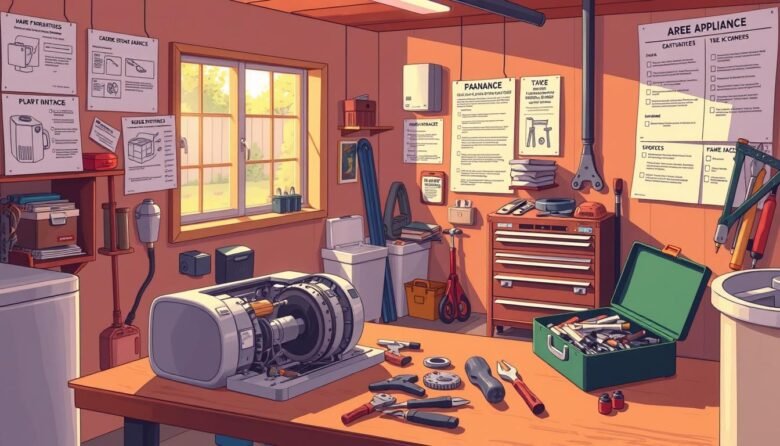Your home’s major equipment represents a significant financial investment. Proper care can dramatically improve how long these items last and how well they perform.
Neglecting your machines leads to early breakdowns and higher operating costs. Simple, proactive habits add years of service and keep everything running smoothly.
You don’t need to be a technician. Based on real repair service data, we’ll show you five key practices. These include regular upkeep and following manufacturer guidelines.
This professional guide offers step-by-step instructions for different types. Consistent habits protect your investment and deliver economic benefits.
Key Takeaways
- Proper care can significantly increase how long your home equipment lasts.
- Simple habits improve performance and reduce operating costs.
- Proactive maintenance prevents many common issues.
- Following manufacturer specifications ensures optimal function.
- Regular upkeep does not require advanced technical skills.
- Good practices can prevent increased energy use from dirty parts.
- Viewing your machines as long-term investments makes care worthwhile.
Why Proactive Appliance Maintenance Is a Smart Investment
Financial wisdom extends beyond stocks and savings to include how we maintain our household equipment. Regular attention prevents minor issues from becoming major expenses.
Data from EasyFix Appliance Repair reveals startling cost differences between neglect and care. A neglected refrigerator’s compressor failure runs $800-$1,200, while proper coil cleaning prevents this entirely.
The High Cost of Neglect Versus the Value of Care
Reactive approaches lead to steep repair bills. Oven control board replacement costs $400-$700, and washer motor repairs average $200-$500.
Proactive habits slash these expenses. Standard TV & Appliance data shows maintained equipment lasts 50% longer. This adds years of service without replacement costs.
Vancouver households with high usage rates report significant savings. Their consistent upkeep routines prevent emergency repairs and unexpected purchases.
Environmental and Economic Benefits of Extended Appliance Life
Extended equipment life delivers dual advantages. You save money while reducing environmental impact.
Maintained refrigerators use up to 25% less power. Clean coils and seals improve efficiency dramatically.
Economic benefits are substantial. Extending service from 10 to 15 years on a $10,000 equipment set saves approximately $3,333.
Environmental gains matter equally. Fewer machines in landfills and reduced manufacturing resources make maintenance ecologically responsible.
Extended warranties can help, but they’re no substitute for proper care. View maintenance as part of your sustainable home strategy.
This approach protects your budget and our planet simultaneously. Smart homeowners recognize this dual benefit.
Mastering the Art of the Appliance Cleaning Routine
Systematic upkeep of your household machines transforms simple chores into powerful longevity strategies. This approach goes beyond surface-level appearance to protect internal components from strain.
Proper maintenance reduces operational stress on mechanical parts. It also prevents common issues that lead to costly repairs.
Refrigerator Condenser Coils: Your Fridge’s Lungs
These coils work like respiratory systems for cooling units. Dust accumulation forces compressors to work harder.
Unplug your unit before starting. Use a vacuum with brush attachment to remove debris gently.
Clean every three months normally. Homes with pets should do this monthly.
EasyFix data shows dirty coils increase power consumption by 25%. Regular attention keeps your refrigerator running efficiently.
Dishwasher Filters: The Key to Clean Dishes and a Healthy Machine
Food particles accumulate in filtration systems over time. This buildup strains water pumps and reduces cleaning performance.
Remove the filter assembly monthly. Rinse thoroughly under hot running water.
Use a soft brush for stubborn debris. Reinstall completely before next use.
Clogged filters cause poor washing results and pump problems. Simple monthly care prevents these issues.
Washing Machine Drums and Seals: Preventing Mold and Mildew
Front-loading models need particular attention to moisture control. Residual detergent and fabric softener create ideal environments for growth.
Run an empty cycle monthly with one cup vinegar. Add baking soda for extra cleaning power.
Wipe rubber seals after each use. Leave the door slightly open between loads for air circulation.
This prevents unpleasant odors and maintains optimal washing conditions. Urban households with frequent usage benefit greatly from this practice.
Range Hood Filters: Eliminating Grease and Fire Hazards
Grease accumulation poses serious safety risks in kitchen ventilation systems. Regular attention eliminates potential fire dangers.
Soak metal filters in hot soapy water monthly. Scrub gently to remove grease buildup.
Replace disposable filters according to manufacturer specifications. Never operate without proper filtration.
Professional repair services report many range hood issues stem from neglected filters. Consistent care ensures safe operation and proper ventilation.
Integrate these practices into monthly and quarterly schedules. Consistent attention protects your investment and maintains peak performance across all household systems.
Avoiding Overload: Respecting Your Appliances’ Capacity Limits
Every piece of equipment in your home has maximum capacity specifications that, when exceeded, accelerate wear and tear. Understanding these boundaries prevents mechanical stress and extends service years significantly.
EasyFix repair data reveals overloading ranks among the top three causes of premature system failure. Vancouver households with heavy usage patterns particularly benefit from capacity awareness.
The Dangers of Overloading Washing Machines and Dryers
Laundry equipment suffers dramatically from excessive loads. Bearings and drive belts experience unnecessary strain when drums contain too many items.
Use the palm test method for optimal loading. Your washing machine should have space for a flat hand above the clothing level.
Dryer overloading presents additional risks. Reduced airflow extends drying times and overworks heating elements.
Lint accumulation increases fire hazards when dryers operate beyond capacity. Motors strain under excessive weight, shortening their operational lifespan.
Optimizing Dishwasher Loading for Performance and Longevity
Proper dish arrangement ensures thorough cleaning and protects internal components. Overlapping plates block spray arms from rotating freely.
Detergent dispenser issues arise when items prevent proper door closure. Water distribution becomes uneven, leaving some items unclean.
Follow manufacturer guidelines for rack arrangement. This prevents mechanical problems and maintains cleaning performance.
Large pots and pans often require separate cycles. This practice prevents overcrowding and ensures optimal results.
Maintaining Proper Airflow in Your Refrigerator
Refrigerator efficiency depends heavily on unrestricted air circulation. Overpacking blocks vents and causes compressor strain.
Maintain clearance around interior vents and avoid blocking the back wall. This prevents temperature inconsistencies throughout the unit.
Excessive compressor cycling occurs when cold air cannot circulate properly. This increases power consumption and mechanical wear.
Organize contents to allow air movement between items. This simple habit improves cooling performance and reduces operational stress.
Respecting capacity limits across all your household systems delivers tangible benefits. You’ll experience better performance, reduced repair needs, and extended equipment life.
Proactive Replacement of Filters, Seals, and Gaskets
Many homeowners overlook the importance of timely filter and seal replacement in their maintenance approach. These components serve as critical barriers against system failures.
Regular attention to these parts prevents minor issues from becoming major expenses. Data from Standard TV & Appliance shows replacement costs average 75% less than repair bills.
Changing Refrigerator Water Filters on Schedule
Replace your refrigerator water filter every six months without exception. Mark this date on your calendar or set smartphone reminders.
Watch for reduced water flow or taste changes between replacements. These signs indicate the filter needs immediate attention.
Neglected filters strain water pumps and reduce system performance. Pump failure repairs cost significantly more than preventive filter changes.
Inspecting and Replacing Dryer Lint Screens
Check your dryer lint screen monthly for tears or damage. Wash it with warm soapy water if clogged with residue.
Replace damaged screens immediately to maintain proper airflow. Restricted airflow forces motors to work harder and shortens their operational years.
This simple monthly check prevents fire hazards and maintains drying efficiency. Many repair cases involve neglected lint screens causing overheating issues.
Testing and Maintaining Refrigerator and Dishwasher Door Seals
Use the dollar bill test monthly for refrigerator and dishwasher door seals. Close the door on a dollar bill and gently pull it out.
Replace the seal if the bill slides out easily without resistance. Proper seals prevent cold air loss and maintain optimal temperature levels.
Dishwasher leaks from faulty seals can damage flooring and cabinetry. Proactive seal replacement avoids these expensive problems.
Checking Oven Door Gaskets for a Tight Seal
Inspect oven door gaskets quarterly for tears or compression issues. Ensure they create a complete seal around the entire door perimeter.
Heat loss from faulty gaskets increases cooking times and energy use. This strains heating elements and reduces overall cooking performance.
Maintain a tight seal to prevent temperature fluctuations during baking. Proper gasket care ensures consistent results and protects your investment.
View filter and seal replacement as affordable preventative measures rather than optional tasks. This approach saves money on future repairs and extends equipment service years.
Set regular reminders for these maintenance activities. Visual inspections during normal use help catch issues early before they escalate.
Consistent attention to these components delivers better performance and prevents unexpected breakdowns. Your household systems will operate more reliably with proper care.
Ensuring Proper Ventilation and Airflow for Optimal Operation
Good airflow management protects your household systems from thermal stress and overheating. Proper ventilation maintains ideal operating temperatures for mechanical components.
Restricted airflow forces motors and compressors to work harder. This reduces efficiency and accelerates wear on critical parts.
EasyFix service data shows ventilation issues cause 30% of premature system failures. Regular attention prevents these common problems.
The Critical Importance of Dryer Vent Cleaning
Lint accumulation in dryer vents creates serious fire hazards. The U.S. Fire Administration reports thousands of residential fires annually from this issue.
Schedule professional vent cleaning every twelve months. High-usage households should do this twice yearly.
Check the external vent flap monthly for proper operation. Ensure it opens freely when the dryer runs.
Restricted airflow causes overheating and motor strain. This leads to expensive repairs and reduced performance.
Urban homes with compact laundry spaces face particular risks. Proper maintenance prevents dangerous lint buildup.
Maintaining Clearance Around Your Refrigerator
Refrigerators require specific spacing for heat dissipation. Follow manufacturer specifications for optimal operation.
Maintain one-inch clearance on sides and top. Allow two inches behind the unit for proper airflow.
Built-in models need careful installation attention. Avoid over-tightening against cabinetry that restricts ventilation.
EasyFix technicians frequently find compressor issues from poor clearance. Overheating reduces system lifespan dramatically.
Proper spacing helps your refrigerator maintain consistent temperatures. This improves food preservation and reduces power use.
Checking Dishwasher and Washing Machine Venting and Spacing
Dishwasher steam vents must remain completely unobstructed. Check where the counter meets the unit for proper clearance.
Adjust vent caps if needed to ensure steam escapes freely. Blocked vents cause moisture issues and reduce cleaning performance.
Washing machines need one to four inches spacing on all sides. This reduces vibration stress during operation cycles.
Proper spacing prevents hose connections from loosening over time. It also minimizes noise and potential leakage problems.
Installation checks ensure your machines operate as designed. This simple verification prevents many common repair issues.
Proper ventilation practices extend component life and prevent thermal damage. Include airflow checks in your regular maintenance schedule.
Professional vent cleaning services provide thorough removal of hazardous accumulations. This investment protects your home and equipment simultaneously.
Operating Appliances According to Their Design Specifications
Using your machines as intended by their creators prevents premature wear and costly repairs. Manufacturer guidelines exist for optimal performance and longevity.
Standard TV & Appliance data shows incorrect use causes 35% of service calls. Following specifications reduces these unnecessary visits.
Proper operation maintains warranty coverage and prevents accelerated deterioration. This approach saves money over the equipment’s service period.
Using the Correct Detergent and Quantities
High-efficiency washers require HE detergent for proper function. Regular formulas create excessive suds that strain pumps and motors.
Follow manufacturer measurements precisely. Overuse leaves residue that reduces cleaning performance.
Adjust quantities based on water hardness. Soft water areas like Vancouver need less detergent for effective results.
Incorrect detergent selection causes multiple issues. Residue buildup affects efficiency and may require professional attention.
Employing Appropriate Temperature Settings
Cold water cycles work well for most laundry loads. They clean effectively while reducing strain on heating elements.
Reserve hot water for heavily soiled items or sanitizing needs. This practice conserves power and extends component life.
Dishwashers benefit from medium temperature settings for regular cycles. Extreme heat accelerates wear on seals and internal parts.
Proper temperature selection improves performance while minimizing mechanical stress. This balanced approach delivers better results.
Running Seasonal Applitches to Prevent Component Seizing
Infrequently used machines need monthly operation to maintain proper function. This prevents seal drying and lubricant solidification.
Window air conditioners should run briefly during cooler months. This keeps compressors and seals in good condition.
Dehumidifiers and portable heaters benefit from occasional use. Regular operation prevents motor issues and maintains performance.
Power management protects electronic components from damage. Surge protectors prevent voltage spikes during storms.
Unplug sensitive equipment during electrical disturbances. Whole-house protection systems offer comprehensive coverage.
Operating within design specifications improves efficiency and prevents unexpected breakdowns. This careful approach extends service life significantly.
Always consult your owner’s manual for specific guidance. Avoid creative uses that may damage internal components.
Recognizing When to Call a Professional for Appliance Repair
Even with excellent home care, some situations require expert attention. Knowing when to seek professional help prevents small problems from becoming major expenses.
Technical expertise becomes essential for complex internal components. Certified technicians possess specialized tools and training for accurate diagnosis.
Identifying Early Warning Signs of Major Failure
Unusual noises often indicate developing mechanical problems. Grinding or squealing sounds suggest worn bearings or belts.
Decreased performance signals internal wear. Longer cycle times or incomplete tasks require investigation.
Visible damage like cracks or leaks demands immediate attention. Electrical issues such as tripping breakers need professional assessment.
Strange odors frequently precede component failure. Burning smells or unusual scents warrant expert evaluation.
Ignoring these warning signs leads to cascade failures. Early intervention often saves the entire system.
Understanding the Cost-Benefit Analysis of Repair vs. Replacement
Standard TV & Appliance data provides clear guidance on replacement decisions. Consider repair when costs stay below 50% of new unit pricing.
A $1,200 refrigerator repair might not make sense when new models cost $2,000. Multiple repairs within short periods suggest replacement time.
Age affects this calculation significantly. Older units nearing expected service limits might not justify major investments.
Energy efficiency improvements in newer models offer additional savings. Modern units often use less power while providing better performance.
Frequent repairs indicate diminishing returns on maintenance investments. Weigh all factors before committing to expensive fixes.
The Value of Annual Professional Maintenance and Tune-Ups
Professional technicians detect issues homeowners might miss. They examine sealed systems and internal components during comprehensive checks.
Annual tune-ups calibrate systems for optimal operation. Technicians adjust settings and test safety features during visits.
EasyFix case studies show early detection saves appliances. Their technicians frequently prevent complete failures through scheduled maintenance.
Choose certified professionals with manufacturer training. Verify credentials and read reviews before scheduling service.
Budget for annual maintenance as part of your care plan. This proactive approach complements your regular home upkeep efforts.
Professional services extend system life and protect your investment. Timely interventions maintain performance while preventing unexpected breakdowns.
Implementing Your Sustainable Appliance Care Plan
Creating a structured maintenance plan ensures your household systems operate reliably for years. Start with one or two simple habits and gradually build your routine.
Establish a clear schedule for upkeep tasks. Monthly checks include filter cleaning and vent inspections. Quarterly tasks involve deeper coil vacuuming and seal examinations.
Annual professional service and part replacement complete your plan. Consistency transforms these actions into powerful protective measures.
This approach delivers better performance and prevents unexpected problems. You’ll enjoy reduced repair costs and improved efficiency over time.
Begin implementing your plan today for long-term benefits. Sustainable care turns your machines into reliable assets that serve your family well.



